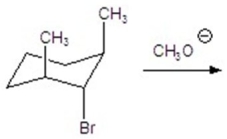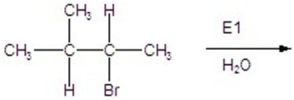Correct Answer

verified
Correct Answer
verified
Essay
Show the carbocation intermediate formed during the synthesis of geraniol by SN1 reaction. 
Correct Answer

verified
Correct Answer
verified
Multiple Choice
Which halide reacts most rapidly via an SN2 mechanism?
A) ![]()
B) ![]()
C) ![]()
D) ![]()
E) ![]()
G) D) and E)
Correct Answer

verified
Correct Answer
verified
Multiple Choice
Which of the following best explains why SN1 reactions involving a neutral reactant are faster in polar solvents?
A) The substrate is more soluble in polar solvents.
B) The substrate is less soluble in polar solvents.
C) The nucleophile is solvated by polar solvents.
D) Solvation by polar solvents stabilizes the carbocation.
E) Solvation by polar solvents stabilizes the transition state.
G) C) and D)
Correct Answer

verified
Correct Answer
verified
Essay
Provide the major organic product(s)in the reaction below. 
Correct Answer

verified
Correct Answer
verified
Essay
Rank the species below in order of leaving group capabilities in SN2 reactions (worst leaving group to best): CH3O-,H2O,C6H5SO3-,H2N-.
Correct Answer

verified
H2N- < CH3O- <...View Answer
Show Answer
Correct Answer
verified
View Answer
Essay
Provide the structure of the major organic product in the following reaction. 
Correct Answer

verified
Correct Answer
verified
Multiple Choice
How many distinct alkene products are possible when the alkyl iodide below undergoes E2 elimination? 
A) 1
B) 2
C) 3
D) 4
E) 5
G) None of the above
Correct Answer

verified
Correct Answer
verified
Essay
Geraniol is a fragrant alcohol found in roses.It is biologically synthesized from geranyl phosphate by SN1.What is the leaving group in this reaction? 
Correct Answer

verified
Correct Answer
verified
Multiple Choice
Which of the following species is the least nucleophilic?
A) (CH3) 3CO-
B) H2O
C) (CH3) 3N
D) BF3
E) CN-
G) B) and E)
Correct Answer

verified
Correct Answer
verified
Multiple Choice
Which of the following is classified as a vinyl halide?
A) CH3CH ![]() CHOH
CHOH
B) CH3CH ![]() CHCl
CHCl
C) CH3CH ![]() CHCH2Cl
CHCH2Cl
D) CH3CH2CH2CH2Br
E) BrCH2CH ![]() CH2
CH2
G) B) and D)
Correct Answer

verified
Correct Answer
verified
Essay
Draw the product of the following reaction. 
Correct Answer

verified
Correct Answer
verified
Multiple Choice
Give the major product for the following E2 reaction. 
A) ![]()
B) ![]()
C) ![]()
D) ![]()
E) no reaction
G) B) and D)
Correct Answer

verified
Correct Answer
verified
Multiple Choice
Give the name(s) of the product(s) for the following SN2 reaction. 
A) (S) -2-hexanol
B) (R) -2-hexanol
C) (S) -3-hexanol
D) (R) -3-hexanol
F) B) and D)
Correct Answer

verified
Correct Answer
verified
Multiple Choice
Which sequence of reagents works best to convert 1-bromobutane to hexane?
A) 1) NaOCH3,CH3OH 2.NaCN 3.Na,NH3
B) 1) NaC ![]() CH 2.H2 (excess) ,Pd/C
CH 2.H2 (excess) ,Pd/C
C) 1) CH3CH2OH,delta 2.H2 (excess) ,Pd/C
D) 1) NaCN 2.BH3*THF 3.HO-,H2O2
E) 1) NaC ![]() CCH2CH3 2.Na,NH3
CCH2CH3 2.Na,NH3
G) None of the above
Correct Answer

verified
Correct Answer
verified
Multiple Choice
The rate of an SN1 reaction is fastest in
A) 100% ethanol.
B) 80% ethanol and 20% water.
C) 50% ethanol and 50% water.
D) 25% ethanol and 75% water.
E) 100% water.
G) B) and C)
Correct Answer

verified
Correct Answer
verified
Essay
Give the mechanism of the reaction shown below. 
Correct Answer

verified
Correct Answer
verified
Essay
Provide the structure of the major organic product of the following reaction. 
Correct Answer

verified
Correct Answer
verified
Essay
Why are vinylic halides unreactive in both SN2 and SN1 reactions?
Correct Answer

verified
Vinylic halides do not undergo SN2 reacti...View Answer
Show Answer
Correct Answer
verified
View Answer
Multiple Choice
Which of the following best describes the carbon-chlorine bond of an alkyl chloride?
A) nonpolar; no dipole
B) polar; δ+ at carbon and δ- at chlorine
C) polar; δ- at carbon and δ+ at chlorine
D) ionic
E) none of the above
G) C) and D)
Correct Answer

verified
Correct Answer
verified
Showing 201 - 220 of 228
Related Exams